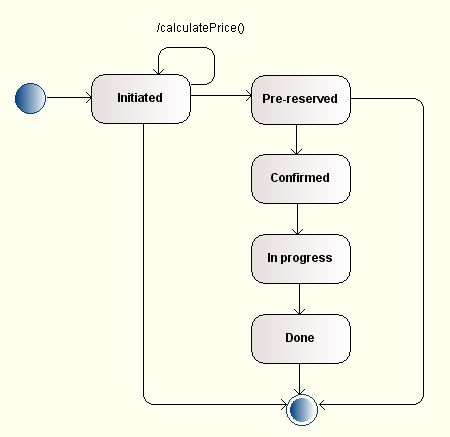State diagrams are a powerful mechanism for formalizing dynamics that can express several aspects of a class.
UML distinguishes protocol state machines from behavioral state machine.
“Protocol” state machines have very simple semantics and can be used for most classes representing a business notion that always has several different states in its life, with these states changing due to business processes and/or the invocation of operations on the representing class.
Modelio supports the latest UML2 evolutions for state machines, such as entry points, exit points and regions.

Activity diagrams are used to model business processes or the dynamic part of a model (an operation’s algorithm, for example). They can be "autonomous" and represent a process, or represent the behavior of an operation. Partitions can be represented horizontally or vertically.
Modelio supports all the detailed features of UML2 activity diagrams. We see here embedded partitions, behavior call actions, pins, received events and data stores.
Modelio makes it quick and easy to create activity diagrams through smart interactions: for example, just drag & drop an operation into an activity diagram to create an “operation call action” that is connected to the operation.
Icons attached to an element express when they are connected (represent, typed by) to other model elements. For example, we see that the "Hotliner" partition has an actor icon, expressing that the partition represents an existing actor (called Hotliner). These features make UML activity diagrams easy to understand and comfortable to use.
BPMN is an OMG standard dedicated to business process modeling. BPMN diagrams specify the details of processes, sequences, events, tasks, gates, lanes, pools, and so on.
Modelio provides integrated support of the BPMN2 and UML2 standards, in order to provide seamless coverage of both UML notions and BPMN elements.
In this example, data flows ("Order" and "Bill") refer to UML classes, while lanes and pools refer to actors or packages, as shown by icons, and one process can call another process or a UML operation.
A requirement specifies a capability or condition that must be satisfied. A requirement can define a function that a system must perform, or a performance condition a system must achieve. A requirement can appear in other diagrams to show its relationships to other model elements. Requirements have properties and links to other elements (requirements or model elements).
Modelio provides a spreadsheet editor dedicated to requirements analysis, as well as graphical support of requirements modeling.
In the example shown on the right, requirements are connected to model elements in order to express the model elements that refine, satisfy or verify them. The "DiscountTravelOrderingSite" component satisfies the "Internet booking access" requirement, because it implements functions related to the requirement. This requirement can be verified by running test cases related to the "Cancel Trip" and "Book Trip" use cases.
Requirement diagrams are based on the OMG’s SysML (System Modeling Language) standard.